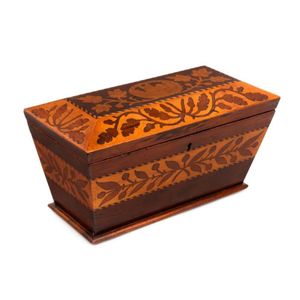In the 17th century, tea was first introduced to Britain from the East Indies by the Dutch East India Company who had a monopoly on this trade, as well as some of the spices now in common use. As a result, the leaf tea from which the drink was made was an extremely expensive commodity, and so had to be appropriately stored and safeguarded. The tea caddy was devised for this purpose.
The first tea caddies, sometimes called tea canisters, as they were only single compartment vessels, were often of silver, and bottle shaped with a removable top that could be used to measure tea into the pot.
In the 18th century, taxes were imposed on tea making it even more expensive, and to safeguard the contents a lockable box was devised. The simple forms of these boxes had a removable receptacle to store the tea. The larger examples housed
more...
two receptacles side by side. The tea containers were often lined with a silver paper like substance presumably to protect the tea from moisture. The tea receptacles were often separated by a glass bowl, usually referred to in auction catalogues as the "mixing bowl" or "blending bowl", the idea being that each of the two containers held a different variety of tea, and they were blended in the bowl in proportions suitable to the maker, before being added to the teapot. Others, however, believe the bowl was used for sugar.
The most common material used for tea caddies in the 18th century was silver, and in the 19th century was wood, but tea caddies are also commonly seen finished in pewter, ivory, tortoise-shell, mother-of-pearl, brass, copper, papier mache and silver.
Befitting their status, the finest materials and craftmanship were used in the manufacture of tea caddies, emphasised by the complicated shapes which were variations on a square, rectangle or casket.
In 1784 the tax on tea was reduced from over 100% to 12.5%, and at the same time the monpoly on supply of tea by the Dutch East india Company was beginning to wane. As tea grew cheaper, there was less concern with safeguarding the contents, and as a result the of the tea caddy slowly declined. Most tea caddies avaiolable on the market were made before the mid 19th century.
A variation on the tea caddy is the teapoy, where a larger version of the tea caddy was mounted on a stem and base to form a small table.
less...


 Loading more...
Loading more...